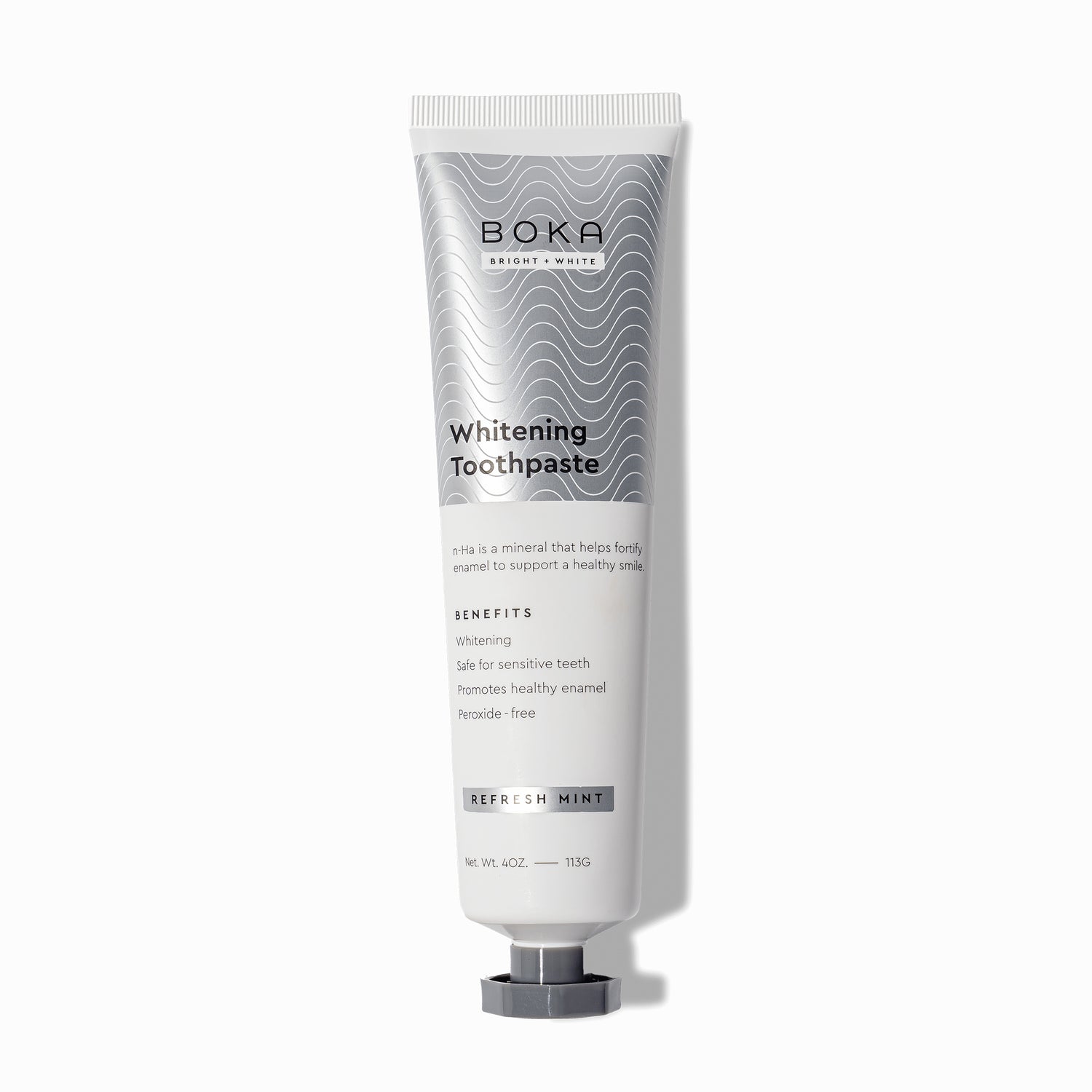The dental industry is a booming sector, with a plethora of research being pumped out every year. New ingredients and formulas are being created constantly as funding and research are increased.
One of the ingredients at the forefront of everyone’s minds is Hydroxyapatite and its counterpart nano-hydroxyapatite.
While Hydroxyapatite is an important part of tooth and bone makeup, nano-hydroxyapatite is what you want if you’re looking to remineralize teeth and fight damage caused by cavities!
Its abilities are comparable to fluoride and it offers an excellent dental-care solution for those who are health-conscious or want to try something different for their teeth.
Unfortunately, hydroxyapatite and nano-hydroxyapatite have yet to hit the mainstream, so there is not a lot of easy-to-understand information out there about the minerals. While there are plenty of scientific articles and journal publications, much of the information out there isn’t easy to understand for someone who hasn’t had any formal dentistry training.
To help you out, we’ve put together this guide to give you all the information you need to figure out what hydroxyapatite and nano-hydroxyapatite are, and which one is right for you. We’ll cover:
- An overview of hydroxyapatite
- An overview of nano-hydroxyapatite
- A direct comparison of the two
- The benefits of nano-hydroxyapatite over hydroxyapatite
- What Boka’s nano-hydroxyapatite toothpaste can do for you.
Let’s get into it!

Overview of Hydroxyapatite
Hydroxyapatite is an inorganic mineral that can be found in both our bones and teeth. It is the naturally occurring form of calcium apatite and can be extracted from plant, biological, marine, and shell sources. The most common way in which it is derived is from the phosphate rock, which is rich in Hydroxyapatite.
It is thought that up to 97% of our teeth are comprised of Hydroxyapatite, making it an important part of the structure and strength of teeth. It is integral to a healthy mouth and can offer defense against plaque and other tooth-related damage.
Overview of Nano-hydroxyapatite
Nano-hydroxyapatite is a synthetic form of Hydroxyapatite that is used in dental care.
Its function is within the remineralization of teeth and works by being absorbed by the teeth and filling any fissures in the enamel caused by demineralization. This allows teeth to become healthier and stronger — building up a defense against further damage from plaque.
It is also thought that n-Ha can smooth out the enamel of teeth and rebuild damage caused by developing cavities.
n-Ha was first used in the 1970s by NASA to remineralize the teeth of astronauts who suffered demineralization in space. Since then, it has become a well-researched and widely-used ingredient in toothpaste and other dental care solutions.
Comparison of hydroxyapatite and nano-hydroxyapatite
|
Property |
Hydroxyapatite (HA) |
Nano-hydroxyapatite (n-Ha) |
|
Origin |
Natural sources such as bone, marine, plants, phosphate rocks |
Synthetic. It is derived from synthesizing hydroxyapatite in solution |
|
Surface area |
126 m2/g, |
9.4 m2/g |
|
Benefits |
Remineralization of teeth and bones, strengthening of teeth and bones, reverse cavities |
Remineralization of teeth and bones, strengthening of teeth and bones, reverse cavities, nontoxic, may treat osteoporosis |
Benefits of nano-hydroxyapatite over hydroxyapatite
You might be wondering which compound wins in the nano-hydroxyapatite vs hydroxyapatite debate.
Nano-hydroxyapatite is technically the synthetic form of hydroxyapatite and they offer the same benefits; however, nano-hydroxyapatite is far superior as it works faster and at a much higher level. Compared to HA, n-Ha is found to have superior properties such as increased solubility, high surface energy, and better biocompatibility.
Hydroxyapatite has long been used as a dental filling material due to the way it can fill in gaps in the enamel and strengthen teeth. It can also be added to toothpaste and other dental care products to assist with the restoration of enamel.
However, the synthesized version (nano-hydroxyapatite or n-Ha) offers a far more advanced and effective solution.
Think of it as the “new and improved” version of hydroxyapatite. If hydroxyapatite is a Honda Civic, nano-hydroxyapatite is a BMW M3; they both have the same function, but one is far more efficient.
This is largely because nano-hydroxyapatite has a far bigger surface area compared to hydroxyapatite. As opposed to being composed of a single large crystal, nano-hydroxyapatite is made up of many small crystals — giving it an increased surface area.
This means the tooth and bone find the absorption of nano-hydroxyapatite much easier than hydroxyapatite, which allows for an increase in benefits and results from the use of the mineral.
Here are some of the key benefits nano-hydroxyapatite can offer compared to hydroxyapatite:
Enhanced absorption
The increased surface area of nano-hydroxyapatite means that it can absorb much easier and more quickly into the tooth compared to hydroxyapatite.
This means that not only will it take less time for you to see results from using a product containing n-Ha, but you will also absorb more of it!
Considering that products containing n-Ha can be on the more expensive side, enhanced absorption is a key selling feature as a little goes a long way.
Improved penetration
Nano-hydroxyapatite’s particles are much smaller than those of hydroxyapatite, therefore it is much easier for the product to penetrate the tooth.
This means that more of the tooth can be remineralized and that the overall effects of nano-hydroxyapatite will be enhanced.
While hydroxyapatite is a good solution for the remineralization of teeth, it is outshone by the penetration abilities of its synthetic counterpart — making the latter a far better solution.
Smoother texture
The fact that nano-hydroxyapatite is made up of numerous small crystals as opposed to one large crystal also means that it works well at smoothing out your teeth, leaving you with a cleaner and brighter smile!
The tiny n-Ha crystals fill in the small crevices in your enamel which prevent your teeth from becoming truly smooth and work to fill in these gaps. This also targets any of those pesky, minuscule stains that may be on the tooth. The overall result is a smoother, whiter, and more radiant smile!
Enhanced bioavailability
Bioavailability is a term that refers to “the extent and rate at which the active moiety (drug or metabolite) enters systemic circulation.”
More simply put, it is the pace at which the drug or substance can be used by its targeted area for its intended effects.
Due to the synthetic nature of nano-hydroxyapatite, its increased surface area, and small crystal formation, the bioavailability of the mineral is far higher than that of hydroxyapatite.
This is a significant advantage as it means n-Ha is far more potent and efficient than its non-synthetic counterpart, making it a much better option. This is crucial as it means the product goes much further, making it better value as well as more potent.
Why You Should Try n-Ha Containing Toothpaste
While we have given all you need to know about n-Ha, you might be wondering why you should try n-Ha-containing toothpaste in the first place!
When reading about all these benefits of nano-hydroxyapatite, you might be drawing some parallels with fluoride. You are correct in thinking this, as fluoride offers some similar benefits to n-Ha in terms of remineralization.
However, one major point of difference is that n-Ha does not come with all the controversy and concern that surrounds fluoride.
This is because n-Ha is a naturally occurring compound that is found in our bodies. Even the synthetic version still mimics what naturally occurs in our teeth, so there is no concern about toxicity or safety.
If you’re health-conscious and care about the ingredients in your products, a n-Ha-containing toothpaste might be the right choice for you.
Furthermore, if you are simply looking for a new product to help you with damaged enamel, n-Ha-containing toothpaste can help.
The primary function of n-Ha is to support enamel health and strength, as well as remove any surface stains. Numerous studies have suggested that n-Ha is a powerful solution to helping with enamel health, with more dental companies starting to turn to n-Ha as an active ingredient in their formulas.
If other products aren’t working for you and you want to improve your smile, a n-Ha containing toothpaste might just do the trick!
Try Boka’s non-toxic and dentist-approved toothpaste

If you think that n-Ha-containing toothpaste is right for you, we have the solution!
The Boka Nano-hydroxyapatite toothpaste range harnesses the properties of n-Ha to create a powerful fluoride-free toothpaste that will leave you with a brighter and more radiant smile.
The toothpaste works to remineralize teeth, support enamel health, maintain healthy teeth and gums, and even close holes in the enamel that cause tooth sensitivity. Additionally, it is sulfate, paraben, artificial flavor, and cruelty-free, as well as vegan — making it suitable for just about anyone!
Our toothpaste is available in a range of different flavors such as watermelon and orange, and even comes in a handy travel size so you can take your toothpaste on the go.
Making the switch to n-Ha toothpaste can be confusing as there is not nearly as much information out there compared to other toothpaste types.
However, with Boka, you can be assured that each and every product is backed by science and is formulated with the best ingredients to give you the best toothpaste possible!

